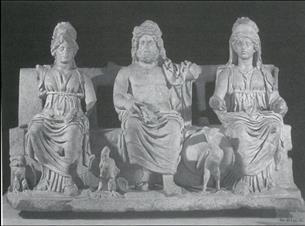Jupiter, Juno Regina, and Minerva

Sculpture of the Capitoline Triad, Archaeological Museum, Palestrina.
(This sculpture was not on the Temple of Jupiter Optimus Maximus).
Although the Temple of Jupiter was dedicated to Roman deities, these deities were originally Etruscan.1 The dedication to a triad rather a single deity shows the clear Etruscan influence, as the Romans did not have a tradition of honoring triads. Of all the Roman gods and goddesses, Jupiter, god of natural phenomena and supremacy, was sovereign.2 Jupiter, Juno his consort (goddess of women), and Minerva his daughter (goddess of handicrafts) completed the Capitoline Triad, a critical element of Roman state religion.3 Largely built on elaborate rituals and sacrifices to the gods, Roman religion focused on “doing, not believing,”4 making the location and site of the Temple of Jupiter even more important. Such rituals and sacrifices would ensure the Roman state’s good fortune and maintain good terms with the gods.5 Jupiter was linked to the founding of Rome, as he had sent a sign to Romulus, the mythological founder of Rome, that he blessed the founding of the city and would protect it.6
1 John W. Stamper, The Architecture of Roman Temples (Cambridge: Cambridge University Press, 2005), 8; Philip V. Hill, The Monuments of Ancient Rome as Coin Types (London: Seaby, 1989), 24.
3 L. Richardson, jr., A New Topographical Dictionary of Ancient Rome (Baltimore: the Johns Hopkins University Press, 1992), 221; John W. Stamper, The Architecture of Roman Temples (Cambridge: Cambridge University Press, 2005), 8; Herbert Jennings Rose and John Scheid, “Minerva,” in The Oxford Companion to Classical Civilization, edited by Simon Hornblower and Anthony Spawforth (Oxford; Oxford University Press, 2003). Accessed 20 December 2016. eISBN: 9780191727368; James Boykin Rives, “Juno,” in The Oxford Companion to Classical Civilization, edited by Simon Hornblower and Anthony Spawforth (Oxford; Oxford University Press, 2003). Accessed 20 December 2016. eISBN: 9780191727368.
4 Mary Beard, SPQR: A History of Ancient Rome (New York: Liveright Publishing Corporation, 2015), 102-103.
5 Mary Beard, SPQR: A History of Ancient Rome (New York: Liveright Publishing Corporation, 2015), 102-103.
6 John W. Stamper, The Architecture of Roman Temples (Cambridge: Cambridge University Press, 2005), 12-13.